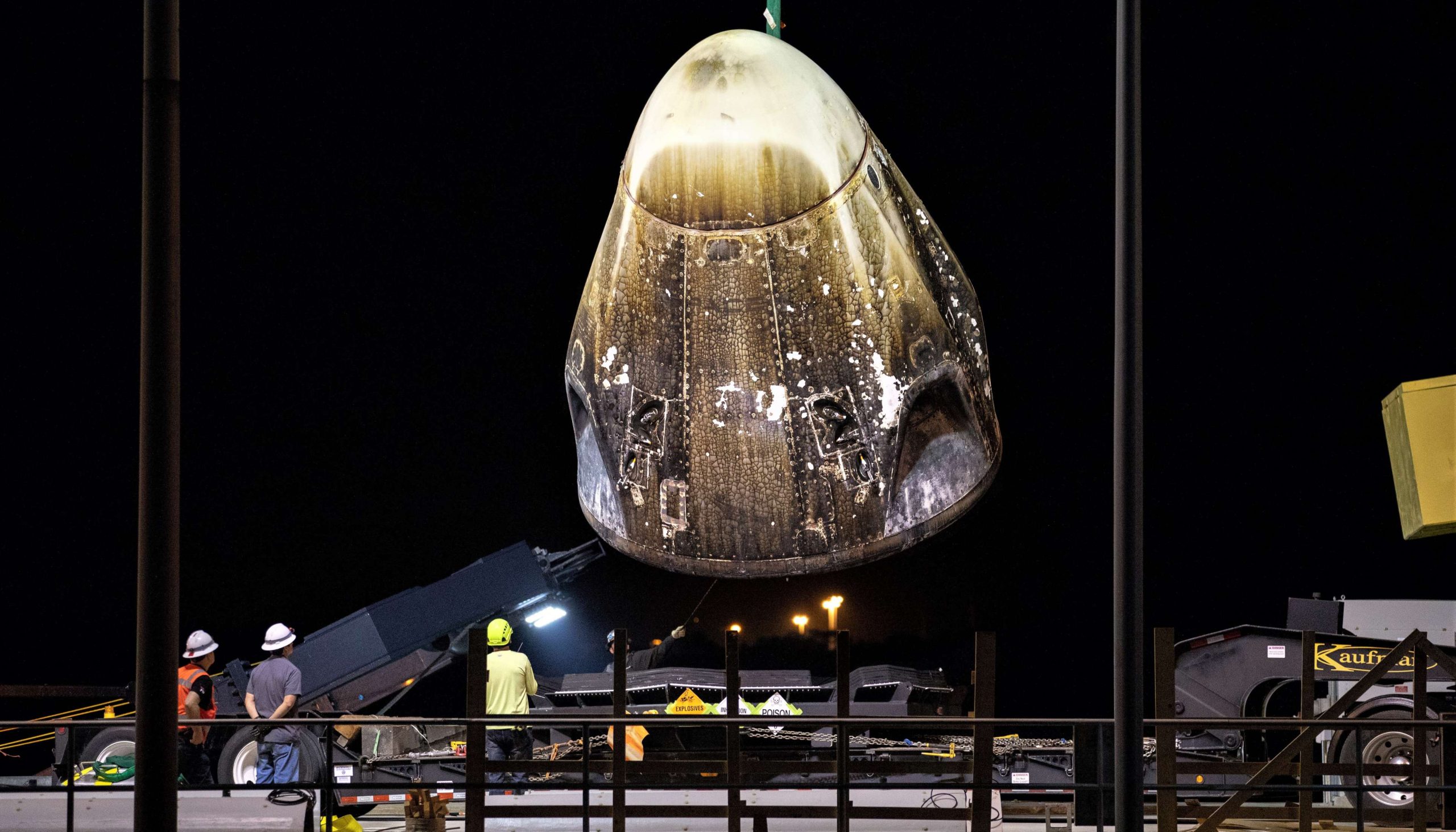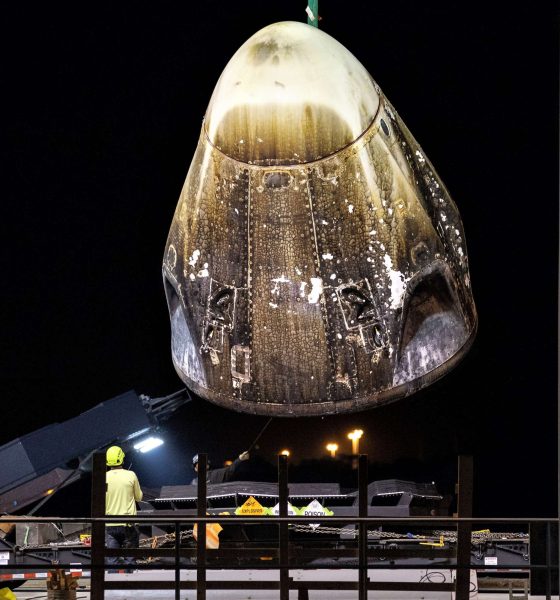

News
SpaceX’s Crew Dragon suffers catastrophic explosion during static fire test
Six weeks after the spacecraft completed its orbital launch debut, SpaceX’s first flight-proven Crew Dragon capsule suffered a catastrophic explosion seconds before a planned SuperDraco test fire.
In the last nine years, SpaceX has successfully built, tested, launched, and recovered Cargo and Crew Dragons 18 times, including five instances of Cargo Dragon capsule reuse, all with minor or no issues. The April 20th event is the first time in the known history of SpaceX’s orbital spacecraft program that a vehicle – in this case, the first completed and flight-proven Crew Dragon capsule – has suffered a total failure. Regardless of the accident investigation’s ultimate conclusions, the road ahead of Crew Dragon’s first crewed test flight has become far more arduous.
According to information acquired by NASASpaceflight.com, SpaceX was in the middle of a series of static fire tests meant to verify that the flight-proven capsule was in good working order after Crew Dragon’s inaugural mission to orbit. The spacecraft was to be tested near SpaceX’s Cape Canaveral Landing Zone facilities, where the company has a small but dedicated space for Dragon tests. Crew Dragon C201’s testing began earlier on Saturday, successfully firing up its smaller Draco maneuvering thrusters. This transitioned into a planned SuperDraco ignition, what would have been the first such integrated test fire for capsule C201.
SpaceX planned to rapidly reuse Crew Dragon C201 for an upcoming in-flight abort (IFA) test, in which the spacecraft would be required to successfully escape from Falcon 9 at the point of peak aerodynamic stress (Max Q). Based on a leaked video of the failure, one or several faults in Crew Dragon’s design and/or build led to a near-instantaneous explosion that destroyed the spacecraft. Sound in the background seems to indicate that the explosion occurred several seconds before the planned SuperDraco ignition, a major concern given their pressure-fed design.
As pressure-fed rocket engines specifically designed to be the basis of a launch escape system, Crew Dragon and its SuperDraco thrusters are meant to be ready to ignite at a millisecond’s notice once they are armed in a flight-ready configuration. It’s safe to say that ten seconds away from a specifically planned ignition is one of those moments, although there is a limited chance that SpaceX’s static fire procedures intentionally diverge from an abort-triggered ignition. Regardless, the fact that Crew Dragon was destroyed before the ignition of its SuperDracos is not an encouraging sign.
Instead of a problem with its high-performance abort thrusters, it can be tentatively concluded that Crew Dragon’s explosion originated in its fuel tanks or propellant plumbing. Such an immediate and energetic explosion points more towards a total failure of propellant lines or valves (or their avionics), while another – and potentially far more concerning – cause could be one of Crew Dragon’s pressure vessels. In a space as enclosed as a Dragon capsule, the rupture of a pressure vessel could trigger a chain reaction of pressure vessel failures, freeing both oxidizer (NTO) and fuel (MMH). Known as hypergolic propellant, NTO and MMH ignite immediately (and violently so) when mixed.
It’s quite possible that the accident investigation to follow will be SpaceX’s most difficult and trying yet. Regardless of the specific cause, the footage of Crew Dragon C201’s demise does not support any positive conclusions about the fate of astronauts or passengers, had they been aboard during the violent explosion. Seemingly triggered in some way by the very system meant to safely extricate Crew Dragon and its astronauts from a failing Falcon 9 rocket, major work will need to be done to prove to NASA that the spacecraft is safe. Sadly, Boeing’s Starliner spacecraft – funded in parallel with Crew Dragon under NASA’s Commercial Crew Program – suffered a far less severe but no less significant failure during a static fire test of its own abort thrusters. Boeing was forced to remove the impacted hardware from its flight plans to extensively clean, repair, and rework the service module.
NASA is now faced with the fact that both of the spacecraft it supported with CCP have exhibited major failures related to their launch escape systems. Crew Dragon’s catastrophic explosion comes as a particularly extreme surprise given how extensively SpaceX has already tested the SuperDraco engines and plumbing, as well as the successful completion of the spacecraft’s launch debut. In the process of DM-1 launch preparations, Crew Dragon likely spent a minimum of 80 minutes with its SuperDraco thrusters and propellant systems primed and ready to abort at any second, apparently without a single mildly-concerning issue.
Godspeed to SpaceX and NASA as they enter into this challenging and unplanned failure investigation.
Check out Teslarati’s Marketplace! We offer Tesla accessories, including for the Tesla Cybertruck and Tesla Model 3.

Elon Musk
Elon Musk’s X will start using a Tesla-like software update strategy
The initiative seems designed to accelerate updates to the social media platform, while maintaining maximum transparency.

Elon Musk’s social media platform X will adopt a Tesla-esque approach to software updates for its algorithm.
The initiative seems designed to accelerate updates to the social media platform, while maintaining maximum transparency.
X’s updates to its updates
As per Musk in a post on X, the social media company will be making a new algorithm to determine what organic and advertising posts are recommended to users. These updates would then be repeated every four weeks.
“We will make the new 𝕏 algorithm, including all code used to determine what organic and advertising posts are recommended to users, open source in 7 days. This will be repeated every 4 weeks, with comprehensive developer notes, to help you understand what changed,” Musk wrote in his post.
The initiative somewhat mirrors Tesla’s over-the-air update model, where vehicle software is regularly refined and pushed to users with detailed release notes. This should allow users to better understand the details of X’s every update and foster a healthy feedback loop for the social media platform.
xAI and X
X, formerly Twitter, has been acquired by Elon Musk’s artificial intelligence startup, xAI last year. Since then, xAI has seen a rapid rise in valuation. Following the company’s the company’s upsized $20 billion Series E funding round, estimates now suggest that xAI is worth tens about $230 to $235 billion. That’s several times larger than Tesla when Elon Musk received his controversial 2018 CEO Performance Award.
As per xAI, the Series E funding round attracted a diverse group of investors, including Valor Equity Partners, Stepstone Group, Fidelity Management & Research Company, Qatar Investment Authority, MGX, and Baron Capital Group, among others. Strategic partners NVIDIA and Cisco Investments also continued support for building the world’s largest GPU clusters.
News
Tesla FSD Supervised wins MotorTrend’s Best Driver Assistance Award
The decision marks a notable reversal for the publication from prior years, with judges citing major real-world improvements that pushed Tesla’s latest FSD software ahead of every competing ADAS system.

Tesla’s Full Self-Driving (Supervised) system has been named the best driver-assistance technology on the market, earning top honors at the 2026 MotorTrend Best Tech Awards.
The decision marks a notable reversal for the publication from prior years, with judges citing major real-world improvements that pushed Tesla’s latest FSD software ahead of every competing ADAS system. And it wasn’t even close.
MotorTrend reverses course
MotorTrend awarded Tesla FSD (Supervised) its 2026 Best Tech Driver Assistance title after extensive testing of the latest v14 software. The publication acknowledged that it had previously criticized earlier versions of FSD for erratic behavior and near-miss incidents, ultimately favoring rivals such as GM’s Super Cruise in earlier evaluations.
According to MotorTrend, the newest iteration of FSD resolved many of those shortcomings. Testers said v14 showed far smoother behavior in complex urban scenarios, including unprotected left turns, traffic circles, emergency vehicles, and dense city streets. While the system still requires constant driver supervision, judges concluded that no other advanced driver-assistance system currently matches its breadth of capability.
Unlike rival systems that rely on combinations of cameras, radar, lidar, and mapped highways, Tesla’s FSD operates using a camera-only approach and is capable of driving on city streets, rural roads, and freeways. MotorTrend stated that pure utility, the ability to handle nearly all road types, ultimately separated FSD from competitors like Ford BlueCruise, GM Super Cruise, and BMW’s Highway Assistant.
High cost and high capability
MotorTrend also addressed FSD’s pricing, which remains significantly higher than rival systems. Tesla currently charges $8,000 for a one-time purchase or $99 per month for a subscription, compared with far lower upfront and subscription costs from other automakers. The publication noted that the premium is justified given FSD’s unmatched scope and continuous software evolution.
Safety remained a central focus of the evaluation. While testers reported collision-free operation over thousands of miles, they noted ongoing concerns around FSD’s configurable driving modes, including options that allow aggressive driving and speeds beyond posted limits. MotorTrend emphasized that, like all Level 2 systems, FSD still depends on a fully attentive human driver at all times.
Despite those caveats, the publication concluded that Tesla’s rapid software progress fundamentally reshaped the competitive landscape. For drivers seeking the most capable hands-on driver-assistance system available today, MotorTrend concluded Tesla FSD (Supervised) now stands alone at the top.
News
Elon Musk’s Grokipedia surges to 5.6M articles, almost 79% of English Wikipedia
The explosive growth marks a major milestone for the AI-powered online encyclopedia, which was launched by Elon Musk’s xAI just months ago.

Elon Musk’s Grokipedia has grown to an impressive 5,615,201 articles as of today, closing in on 79% of the English Wikipedia’s current total of 7,119,376 articles.
The explosive growth marks a major milestone for the AI-powered online encyclopedia, which was launched by Elon Musk’s xAI just months ago. Needless to say, it would only be a matter of time before Grokipedia exceeds English Wikipedia in sheer volume.
Grokipedia’s rapid growth
xAI’s vision for Grokipedia emphasizes neutrality, while Grok’s reasoning capabilities allow for fast drafting and fact-checking. When Elon Musk announced the initiative in late September 2025, he noted that Grokipedia would be an improvement to Wikipedia because it would be designed to avoid bias.
At the time, Musk noted that Grokipedia “is a necessary step towards the xAI goal of understanding the Universe.”
Grokipedia was launched in late October, and while xAI was careful to list it only as Version 0.1 at the time, the online encyclopedia immediately earned praise. Wikipedia co-founder Larry Sanger highlighted the project’s innovative approach, noting how it leverages AI to fill knowledge gaps and enable rapid updates. Netizens also observed how Grokipedia tends to present articles in a more objective manner compared to Wikipedia, which is edited by humans.
Elon Musk’s ambitious plans
With 5,615,201 total articles, Grokipedia has now grown to almost 79% of English Wikipedia’s article base. This is incredibly quick, though Grokipedia remains text-only for now. xAI, for its part, has now updated the online encyclopedia’s iteration to v0.2.
Elon Musk has shared bold ideas for Grokipedia, including sending a record of the entire knowledge base to space as part of xAI’s mission to preserve and expand human understanding. At some point, Musk stated that Grokipedia will be renamed to Encyclopedia Galactica, and it will be sent to the cosmos.
“When Grokipedia is good enough (long way to go), we will change the name to Encyclopedia Galactica. It will be an open source distillation of all knowledge, including audio, images and video. Join xAI to help build the sci-fi version of the Library of Alexandria!” Musk wrote, adding in a later post that “Copies will be etched in stone and sent to the Moon, Mars and beyond. This time, it will not be lost.”








